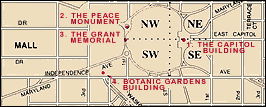

The United States Capitol building.
Beginning at the southeast corner of the building, by using binoculars we can see some areas of blackened alyeration in the Corinthian column capitals. A more accessible example is found under the overhang of the large square ends of the marble balustrade at the southeast comer of the building. The black crust is made of gypsum plus dirt that accumulates in sheltered areas. No black crust is present along the cracks between the stones; rain water probably flows in these areas, dissolving the gypsum and preventing accumulation of a crust. Not all black areas on this baluster are gypsum; in some places near the bushes, you can see greenish-black moss growing on the stone. The top surfaces of the marble balustrade are coarse and rough, because of dissolution between grains, compared to areas that are protected from running or washing water where the black alteration crust forms.
 |
| Blackened alteration has accumulated under the overhanging edge of this marble balustrade corner, Southeast corner, U S. Capitol Building. |

|
| Pock marks in marble columns, south side of U.S. Capitol building. Silicate mineral inclusions in the marble loosen and fall out when the calcite around them is dissolved by acid rain. |
Another dissolution feature of marble is the pock-mark effect on the square bases of the building columns. Silicate mineral inclusions in the marble were loosened by the dissolution of the surrounding calcite, causing the inclusions to fall out of the stone. A particularly good example of this is found on the fourth column west from the southeast comer of the Capitol building. The pockmark dissolution is also found at several other places on the building.
We will follow the marble balustrade around the building, noting differences in deterioration. Some parts of the balustrade have obviously been replaced, thus enabling us to observe various stages in the stone deterioration. The edges of the balusters are sharp when new and become rounded as they age. Blackened alteration crusts have accumulated on the sheltered sides of the balusters and under the overhanging top of the balustrade.

|
|
| The marble balustrade on the west side of the Capitol building shows both dissolution and alteration. | |
 |
 |
| A recently replaced marble baluster at the Capitol has edges that are only beginning to round. | Black alteration crusts under the west balustrade of the Capitol have begun to spall (peel off), revealing crumbling white marble underneath. |

|
|
| A marble block that forms the northeast corner of the Capitol balustrade shows preferential erosion of the calcite around a silicate mineral inclusion. | |
In some spots under the rail the blackened crust has spalled off, exposing fresh surfaces and more vulnerable stone. Some carvings on the balustrade corners are worn, whereas others have blackened alteration; this difference in weathering may be due to local effects of wind and rain. Along the steps leading to the terrace on the west side of the Capitol, gypsum has accumulated on large areas of the wall. Gypsum can accumulate on any surface that is not washed by water.
As you walk north along the west side of the Capitol, look at the central part of the building. The walls here are painted sandstone. Despite recent restoration of the building, you can see evidence of past stone deterioration, including the accentuated lines from bedding in the stone and the pock marks where rounded inclusions have disappeared. We will see an example of this same sandstone that is not painted in the buildings near 17th Street.
At the northeast corner of the Capitol building, the marble balustrade ends in square blocks like the ones we first examined. Here you can see an example of preferential dissolution where the silicate mineral inclusions remain and the calcite around them has been dissolved away. Also, on the north side of this block, examine the blackened grains on the top surface with a hand lens. Not all of the black material you see on stone is gypsum; some is of biological origin, probably algae or a fungus.

Sites 1-4
Map of All Sites on the Tour
[102 K image]